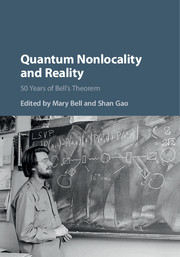Book contents
- Frontmatter
- Contents
- Contributors
- Preface
- Preface
- Part I John Stewart Bell: The Physicist
- Part II Bell's Theorem
- Part III Nonlocality: Illusion or Reality?
- 9 Strengthening Bell's Theorem: Removing the Hidden-Variable Assumption
- 10 Is Any Theory Compatible with the Quantum Predictions Necessarily Nonlocal?
- 11 Local Causality, Probability and Explanation
- 12 The Bell Inequality and the Many-Worlds Interpretation
- 13 Quantum Solipsism and Nonlocality
- 14 Lessons of Bell's Theorem: Nonlocality, Yes; Action at a Distance, Not Necessarily
- 15 Bell Nonlocality, Hardy's Paradox and Hyperplane Dependence
- 16 Some Thoughts on Quantum Nonlocality and Its Apparent Incompatibility with Relativity
- 17 A Reasonable Thing That Just Might Work
- 18 Weak Values and Quantum Nonlocality
- Part IV Nonlocal Realistic Theories
- Index
- References
18 - Weak Values and Quantum Nonlocality
from Part III - Nonlocality: Illusion or Reality?
Published online by Cambridge University Press: 05 September 2016
- Frontmatter
- Contents
- Contributors
- Preface
- Preface
- Part I John Stewart Bell: The Physicist
- Part II Bell's Theorem
- Part III Nonlocality: Illusion or Reality?
- 9 Strengthening Bell's Theorem: Removing the Hidden-Variable Assumption
- 10 Is Any Theory Compatible with the Quantum Predictions Necessarily Nonlocal?
- 11 Local Causality, Probability and Explanation
- 12 The Bell Inequality and the Many-Worlds Interpretation
- 13 Quantum Solipsism and Nonlocality
- 14 Lessons of Bell's Theorem: Nonlocality, Yes; Action at a Distance, Not Necessarily
- 15 Bell Nonlocality, Hardy's Paradox and Hyperplane Dependence
- 16 Some Thoughts on Quantum Nonlocality and Its Apparent Incompatibility with Relativity
- 17 A Reasonable Thing That Just Might Work
- 18 Weak Values and Quantum Nonlocality
- Part IV Nonlocal Realistic Theories
- Index
- References
Summary
Entanglement and nonlocality are studied in the framework of pre-/postselected ensembles with the aid of weak measurements and the two-state-vector formalism. In addition to the EPR–Bohm experiment, we revisit the Hardy and Cheshire Cat experiments, whose entangled pre- or postselected states give rise to curious phenomena. We then turn to even more peculiar phenomenon suggesting “emerging correlations” between independent preand postselected ensembles of particles. This can be viewed as a quantum violation of the classical “pigeonhole principle.”
Introduction
It is seldom acknowledged that seven years before the celebrated Bell paper [1], Bohm and Aharonov [2] published an analysis of the EPR paradox [3]. They suggested an experimental setup, based on Compton scattering, for testing nonlocal correlations between the polarizations of two annihilation photons. In 1964, Bell proposed his general inequality, thereby excluding local realism. During the same time, Aharonov et al. constructed the foundations of a time-symmetric formalism of quantum mechanics [4]. While Bell's proof utilizes entanglement to demonstrate nonlocal correlations,wewill describe inwhat follows the emergence of nonlocal correlations between product states. For this purpose, however, we shall invoke weak measurements of pre- and postselected ensembles.
In classical mechanics, initial conditions of position and velocity for every particle fully determine the time evolution of the system. Therefore, trying to impose an additional final condition would lead either to redundancy or to inconsistency with the initial conditions. This is radically different in quantum mechanics. Because of the uncertainty principle, an initial state vector does not fully determine, in general, the outcome of a future measurement. However, adding a final (backward-evolving) state vector results in a more complete description of the quantum system in between these two boundary conditions, which has a bearing on the determination of measurement outcomes.
The basis for this time-symmetric formulation of quantum mechanics was laid down by Aharonov, Bergman, and Lebowitz (ABL), who derived a symmetric probability rule concerning measurements performed on systems, while taking into account the final state of the system, in addition to the usual initial state [4].
- Type
- Chapter
- Information
- Quantum Nonlocality and Reality50 Years of Bell's Theorem, pp. 305 - 314Publisher: Cambridge University PressPrint publication year: 2016
References
- 2
- Cited by



